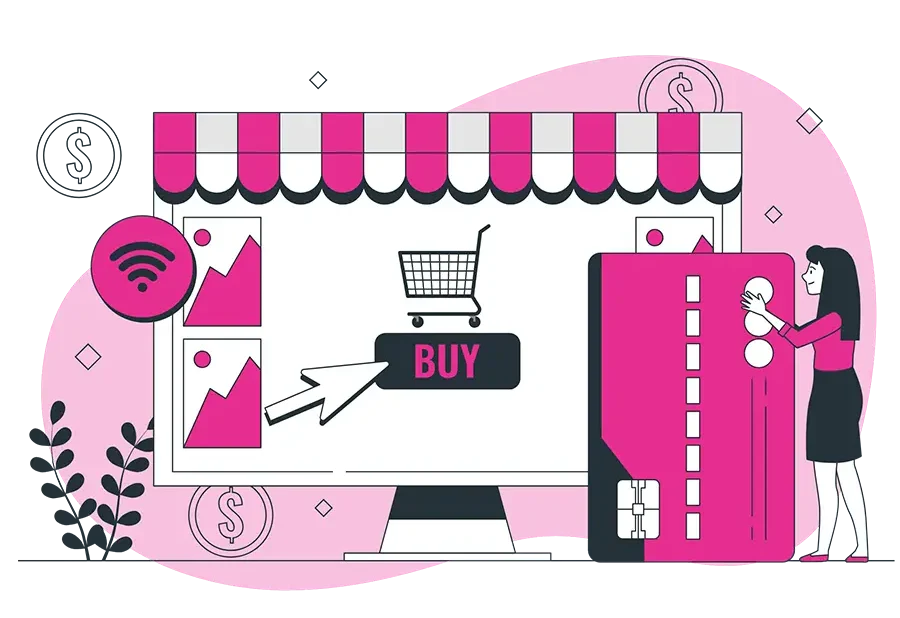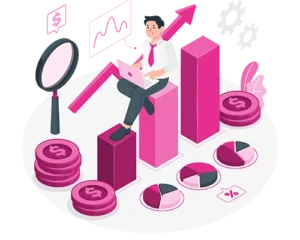Welcome to the evolving landscape of ecommerce profitability! According to Shopify, 10% is an average ecommerce profit margin, 20% would be the highest, and 5% is just considered low as a general rule of thumb.
Your profit margin is not a given number, it’s biding in potential waiting to be released. Industry norms, brand perception, even your niche – all this influences what we can call the unique profit fingerprint.
Ready to grow beyond average and see just what your business is capable of? So, strap in because we are unveiling one by one the mysteries of ecommerce profitability and disclosing fail-proof approaches on how to give mediocrity nothing but dust!
Table of Contents
ToggleWhat is the Ecommerce Profit Margin?
The ecommerce profit margin is the profit percentage retained from revenue after eliminating the cost of goods sold (COGS). It is a key metric for analyzing the financial condition, obtained by dividing profit by revenues and expressed as a percentage.
For instance, a 40% margin of profitability means that 40 cents of each dollar that is made goes to profit. Understanding and maximizing this measure is critical for e-commerce businesses seeking long-term growth and profitability.
A good margin of profit ensures that the company is not only covering its expenses but simultaneously offering a decent return on investment.
Different profit margins, such as gross, operational, and net profit margins, provide additional details about different components of business activities.
Profit Margin is Not Final Profit, Why is it Important?
Profit margin is a key indication of an organization’s financial stability and effectiveness in operation. Here’s why it is so important:
1. Financial Health
A good margin of profit helps to guarantee that a company generates sales while simultaneously maintaining a reasonable degree of profitability. Also, check out how much time Ecom business takes to make profits.
2. Sustainability
Businesses with high margins of profit are more equipped to adapt to economic shifts and unanticipated challenges. It serves as monetary support, assisting an organization to absorb disruptions and maintain operations efficiently.
3. Strategic Decision-Making
Knowing that profit margins are essential for making intelligent choices. It empowers organizations to establish competitive prices, distribute resources more effectively, and uncover possibilities for reducing costs.
4. Investor Confidence
When deciding whether or not to invest, stakeholders and investors alike frequently examine profit margins. A continual margin signals a properly managed and potentially profitable organization, building confidence in investors.
5. Competitive Edge
Companies with optimal profit margins might be stronger contenders in the marketplace than others. To remain competitive, they can endure price stresses, provide better-quality services or goods, and engage in advertising and consumer interaction improvements.
5 Factors Influencing Ecommerce Profit Margin
We have discussed the importance of e-commerce profit margin, and now is the time to tell you the factors that influence it.
1. Cost of Goods Sold (COGS)
The direct costs involved in producing or purchasing the goods being provided. Obtaining good terms with suppliers and streamlining the manufacturing procedures might help minimize COGS.
2. Pricing Strategy
Profit margins are directly impacted by the form of pricing used, which might be the cost-plus approach, based on values or fluid. Strategic choices regarding pricing may reach a balance between competence and profitability.
3. Operational Efficiency
Operational efficiency is a cost-cutting opportunity for enterprises. Implementing automation, optimizing inventory management, and ensuring order fulfillment are major advances.
Here’s the kicker: Web development is the key. An excellent and responsive website streamlines these processes, making them more efficient, cost-effective, and business-oriented.
4. Marketing and Advertising Techniques
Marketing campaigns, publicity, and promotional expenditures all have an impact on the total costs.
Here are some of the marketing and advertising techniques:
- Digital Marketing Strategies: Use online channels like social media and SEO to reach a larger audience and increase company visibility.
- Targeted Marketing Campaigns: Concentrate marketing efforts on specific demographics to maximize impact while reducing unnecessary expenses.
- Email Marketing: Create and develop consumer relationships with tailored email campaigns that include personalized content and promotions.
- Influencer Collaborations: Expand your brand’s reach by collaborating with influencers and tapping into their established following for increased exposure.
Improve your marketing game by utilizing effective SEO services. Hiring an SEO specialist will help you easily combine these approaches and boost your online visibility.
Also, check out 11 Most Used Ecom Marketing Ideas
5. Customer Acquisition and Retention
The expense of recruiting new consumers as well as retaining existing ones influences revenue. Implementing loyalty schemes for customers while offering excellent client experiences can help boost retention.
6 Strategies to Boost Ecommerce Profit Margin
As you are now aware of these factors, it’s time to guide you about the strategies for boosting e-commerce profit margin.
1. Dynamic Pricing Strategies
Dynamic approaches to pricing are vital to expanding e-commerce profit margins. This strategy, which adjusts based on customer demand and a value-based price framework, enables firms to stay competitive while benefiting from the alleged worth of what they offer.
2. Streamlined Cost Management
Effective methods for reducing expenses include effective procurement processes, supplier engagement tactics, and the use of technological advances for automation. These approaches improve the company’s efficiency, resulting in higher profits.
3. Smart Inventory Practices
Effective cost-cutting tactics include effective procurement processes, supplier negotiating tactics, and the use of modern technology for automation. These approaches promote the company’s efficiency, resulting in improved profit.
4. Targeted Digital Marketing
Tailored and inexpensive digital marketing, with a concentration on high-return routes, provides the potential to significantly raise profit margins.
Using tactics like digital advertising and social media platforms enables firms to widen their reach, interact effectively with customers, and enhance overall marketing ROI.
5. Strategic Sales Techniques
Encouraging clients to raise their buying value using strategic advertising techniques such as cross-selling and upselling is an effective strategy.
Businesses can improve the purchasing procedure and typical transaction values by promoting complementary or updated goods, as well as customizing suggestions.
6. User Friendly Website
While dynamic pricing, smart inventory, and targeted marketing are key to profitability, they cannot be maximized without a friendly website. Visualize your website as the storefront where customers first come across your brand, look around, and purchase.
A slow-loading, clunky website with confusing navigation or an irritating checkout can quickly drive your audience away and cost you money.
Investing in SEO of your e-commerce website doesn’t just attract customers, it retains them, ultimately translating into sustainable profit growth.
Don’t wait, and get high-quality SEO services to boost your profitability!
The Effect of Upselling and Cross-Selling on Average Order Value
In the fast-paced world of e-commerce, the art of upselling and cross-selling stood out as a successful technique for increasing company earnings.
Upselling involves urging clients to choose higher-priced or more advanced versions of their intended decisions, leveraging additional attributes or superior quality.
Cross-selling, on the other hand, introduces supportive products, which broadens a consumer’s buying excursion and increases the overall transaction’s value.
Customization is important, as it uses information analysis to customize solutions to individual desires and needs.
Strategic product bundling, straightforward disclosure of extra value, and an effortless shopping experience all help to increase the impact of these strategies.
Following the purchase contact via mail or alerts offers additional possibilities for suggestive advertisement.
Tools and Metrics for Profit Margin Analysis
| Category | Tools/Metrics |
| Platforms for Analysis of Ecommerce | Google Analytics, Adobe Analytics |
| Advanced Ecommerce Analytics Tools | |
| Tools to calculate profit margin | Online Calculators |
| Financial Software/Spreadsheets Integration | |
| Software for Cost Accounting | QuickBooks, Xero, FreshBooks |
| Systems for Inventory Management | TradeGecko, Zoho Inventory |
| Customer Relationship Management | Salesforce, HubSpot |
| CRM Analytics for Customer Insights | |
| Platforms for A/B Testing | Optimizely, VWO |
| Return on Investment (ROI) Metrics | ROI Calculators |
| Advertising Platforms Built-in ROI Features | |
| Dashboard and Reporting Tools | Tableau, Klipfolio |
| Comprehensive Reporting Tools | |
| Pricing Optimization Software | Prisync, Wiser |
| Dynamic Pricing Tools |
Profit Margin Challenges: Strategies for Ecommerce Success
Below are some common mistakes and challenges in profit margin management:
1. Inaccurate Cost Tracking
Pitfall: Failure to precisely monitor costs of goods sold (COGS) and operational expenditures.
Challenge: To set up robust cost accounting procedures and conduct periodic checks to ensure precise cost monitoring.
2. Overlooking Hidden Costs
Pitfall: Ignoring hidden or unforeseen expenditures, such as return shipping, return shipping, or regulatory costs related to compliance.
Challenge: Performing complete cost evaluations to identify and consider every possible concealed cost.
3. Failure to Adapt Pricing Strategies
Pitfall: Using static methods for pricing that cannot adapt to market shifts or client tastes.
Challenge: To implement changing pricing models and on occasion reassess pricing approaches to market terms.
4. Poor Inventory Management
Pitfall: Inefficient management of inventory, which leads to excessive stock or shortages of products.
Challenge: Using management of inventory systems to enhance stock levels, lower cost of holding, and improve total supply chain efficiency.
5. Ignoring Competitor Pricing
Pitfall: Failing to track and alter cost based on a rival’s approach.
Challenge: Using evaluation tools while remaining current on market price patterns.
FAQs
What is a good profit margin in ecommerce?
According to Shopify, a high-profit margin in e-commerce would be around 20%.
Is Ecommerce profitable?
The simple answer is Yes; it is very profitable for every business in the modern world, but it needs effective strategies to work on.
What is the difference between margin and profit?
Margin stands for the percentage gap between the cost of goods sold and the selling price whereas profit represents the amount earned after subtracting all costs from revenue. Margin is a ratio while profit denotes concrete figures.
Invest in Ecommerce Prosperity Today!
In the volatile world of online shopping, good ecommerce profit margin control is critical for long-term profitability. Addressing issues such as accurate cost recording, adaptable pricing, and strategic inventory management is essential.
Implementing these strategies allows organizations to not only handle problems but also establish themselves for wealth in the continually evolving ecommerce industry.
Related Articles









